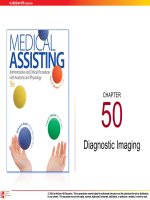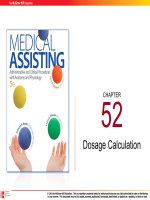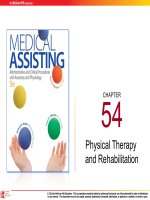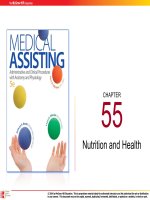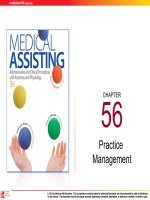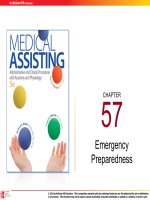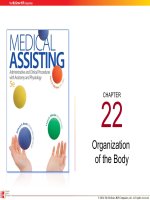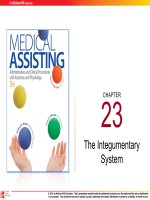Medical assisting Administrative and clinical procedures (5e) Chapter 46 Microbiology and disease
Bạn đang xem bản rút gọn của tài liệu. Xem và tải ngay bản đầy đủ của tài liệu tại đây (1.05 MB, 63 trang )
CHAPTER
46
Microbiology and
Disease
© 2014 by McGraw-Hill Education. This is proprietary material solely for authorized instructor use. Not authorized for sale or distribution
in any manner. This document may not be copied, scanned, duplicated, forwarded, distributed, or posted on a website, in whole or part.
46-2
Learning Outcomes
46.1
Explain the medical assistant’s role in microbiology.
46.2
Describe how microorganisms cause disease.
46.3
Describe how microorganisms are classified and
named.
46.4
Discuss the role of viruses in human disease.
46.5
Discuss the symptoms of HIV/AIDS and hepatitis.
46.6
Discuss the role of bacteria in human disease.
© 2014 by McGraw-Hill Education. This is proprietary material solely for authorized instructor use. Not authorized for sale or distribution
in any manner. This document may not be copied, scanned, duplicated, forwarded, distributed, or posted on a website, in whole or part.
46-3
Learning Outcomes (cont.)
46.7
Discuss the role of protozoa in human disease.
46.8
Discuss the role of fungi in human disease.
46.9 Discuss the role of multicellular parasites in human
disease.
46.10 Describe the process involved in diagnosing an
infection.
46.11 Identify general guidelines for obtaining specimens.
© 2014 by McGraw-Hill Education. This is proprietary material solely for authorized instructor use. Not authorized for sale or distribution
in any manner. This document may not be copied, scanned, duplicated, forwarded, distributed, or posted on a website, in whole or part.
46-4
Learning Outcomes (cont.)
46.12 Carry out the procedure for transporting specimens
to outside laboratories.
46.13 Describe two techniques used in the direct
examination of culture specimens.
46.14 Carry out the procedure for preparing and
examining stained specimens.
46.15 Carry out the procedure for culturing specimens in
the medical office.
46.16 Describe how to perform an antimicrobial sensitivity
determination.
© 2014 by McGraw-Hill Education. This is proprietary material solely for authorized instructor use. Not authorized for sale or distribution
in any manner. This document may not be copied, scanned, duplicated, forwarded, distributed, or posted on a website, in whole or part.
46-5
Introduction
• Microorganisms
• Medical assistant
– Everywhere in the
environment
– Identification of
microorganisms
– Cause disease if
– Proper collection
techniques
• Pathogenic in
nature
• Displaced from
their natural
environment
– Testing procedures
– Quality control
© 2014 by McGraw-Hill Education. This is proprietary material solely for authorized instructor use. Not authorized for sale or distribution
in any manner. This document may not be copied, scanned, duplicated, forwarded, distributed, or posted on a website, in whole or part.
Microbiology and the Role of the
Medical Assistant
46-6
• Microbiology – study of microorganisms
• Microorganisms
– Resident normal flora
– Pathogens
• Medical assistant
– Assist the physician
– Preparing specimens
© 2014 by McGraw-Hill Education. This is proprietary material solely for authorized instructor use. Not authorized for sale or distribution
in any manner. This document may not be copied, scanned, duplicated, forwarded, distributed, or posted on a website, in whole or part.
46-7
Apply Your Knowledge
What role does the medical assistant play in
relation to microbiology?
ANSWER: The medical assistant may assist the
physician in obtaining specimens, obtain specimens
herself, prepare specimens for direct examination or
transport to a reference laboratory, and possibly
perform microbiologic procedures.
© 2014 by McGraw-Hill Education. This is proprietary material solely for authorized instructor use. Not authorized for sale or distribution
in any manner. This document may not be copied, scanned, duplicated, forwarded, distributed, or posted on a website, in whole or part.
46-8
How Microorganisms Cause Disease
• Extensive variety of pathogens
• People normally are able to avoid infection
• Cause disease in variety of ways
• May remain localized or become systemic
• Transmitted directly or indirectly
© 2014 by McGraw-Hill Education. This is proprietary material solely for authorized instructor use. Not authorized for sale or distribution
in any manner. This document may not be copied, scanned, duplicated, forwarded, distributed, or posted on a website, in whole or part.
Classification and Naming of
Microorganisms
46-9
• Classification by structure
– Subcellular
– Prokaryotic
– Eukaryotic
• Standardized naming
– Genus ~ biologic classification
– Species of organism ~ distinct type of
microorganism
© 2014 by McGraw-Hill Education. This is proprietary material solely for authorized instructor use. Not authorized for sale or distribution
in any manner. This document may not be copied, scanned, duplicated, forwarded, distributed, or posted on a website, in whole or part.
46-10
Classification and Naming of Microorganisms
(cont.)
• Standardized naming
– Genus
• Category of biologic classification
• Example – Staphylococcus
– Species of organism
• Represents a distinct type of microorganisms
• Examples – Staphylococcus aureus and
Staphylococcus epidermidis
© 2014 by McGraw-Hill Education. This is proprietary material solely for authorized instructor use. Not authorized for sale or distribution
in any manner. This document may not be copied, scanned, duplicated, forwarded, distributed, or posted on a website, in whole or part.
46-11
Apply Your Knowledge
1.
How do microorganisms cause disease?
ANSWER: Organisms cause disease by using nutrients needed by
cells and tissues, damaging cells directly, causing to body’s
defenses to attack the cell, or producing toxins.
2. Describe the classifications of microorganisms and give
an example of each.
ANSWER: Microorganisms are classified as:
Subcellular organisms – viruses
Prokaryotic organisms – bacteria
Eukaryotic organisms – protozoans, fungi, and parasites
© 2014 by McGraw-Hill Education. This is proprietary material solely for authorized instructor use. Not authorized for sale or distribution
in any manner. This document may not be copied, scanned, duplicated, forwarded, distributed, or posted on a website, in whole or part.
46-12
Viruses
• Smallest known infectious
agents
• Subcellular microorganism
– Have only nucleic acid
surrounded by a protein coat
Hepatitis Virus
– Must live and grow in living cells of other
organisms
© 2014 by McGraw-Hill Education. This is proprietary material solely for authorized instructor use. Not authorized for sale or distribution
in any manner. This document may not be copied, scanned, duplicated, forwarded, distributed, or posted on a website, in whole or part.
46-13
Significant Bloodborne Pathogens
• Medical assistants must understand
– How HIV and hepatitis cause infection
– Risk factors
– Progression of the infections
– Treatments
– Special precautions
© 2014 by McGraw-Hill Education. This is proprietary material solely for authorized instructor use. Not authorized for sale or distribution
in any manner. This document may not be copied, scanned, duplicated, forwarded, distributed, or posted on a website, in whole or part.
46-14
AIDS/HIV Infection
• HIV – virus
• HIV infection AIDS
• The HIV virus destroys
– Helper T cells
– Neurons
• Patients develop opportunistic infections
© 2014 by McGraw-Hill Education. This is proprietary material solely for authorized instructor use. Not authorized for sale or distribution
in any manner. This document may not be copied, scanned, duplicated, forwarded, distributed, or posted on a website, in whole or part.
46-15
AIDS/HIV Infection (cont.)
• Risk factors
– Unprotected sexual
activity
– Sharing needles
used by IV drug
users
– Passes from
mother to fetus or
infant
• Risk in the medical
community
– Percutaneous
exposure
– Mucocutaneous
exposure
© 2014 by McGraw-Hill Education. This is proprietary material solely for authorized instructor use. Not authorized for sale or distribution
in any manner. This document may not be copied, scanned, duplicated, forwarded, distributed, or posted on a website, in whole or part.
46-16
AIDS/HIV Infection (cont.)
• Progression of the infection
– Initial infection ~ may occur years before
symptoms
– Incubation period
• Virus becomes inactive
• Lasts 8 to 15 years
– Full-blown AIDS
• 200 or less helper T cells / mL blood
• Opportunistic infections and neurological
deterioration
© 2014 by McGraw-Hill Education. This is proprietary material solely for authorized instructor use. Not authorized for sale or distribution
in any manner. This document may not be copied, scanned, duplicated, forwarded, distributed, or posted on a website, in whole or part.
46-17
AIDS/HIV Infection (cont.)
• Diagnosis
– Rapid HIV test
– Confirmatory blood tests
• Enzyme-linked immunosorbent assay (ELISA)
• Western Blot Test
• Immunofluorescent antibody (IFA)
– Positive results in two of three positive –
accurate diagnosis
– Home test available
© 2014 by McGraw-Hill Education. This is proprietary material solely for authorized instructor use. Not authorized for sale or distribution
in any manner. This document may not be copied, scanned, duplicated, forwarded, distributed, or posted on a website, in whole or part.
46-18
AIDS/HIV Infection (cont.)
• Symptoms
– Peripheral nervous
systems
– Systemic
– Respiratory
– Oral
– Skin-related
– Kaposi’s sarcoma
– Gastrointestinal
– Central nervous
symptoms
© 2014 by McGraw-Hill Education. This is proprietary material solely for authorized instructor use. Not authorized for sale or distribution
in any manner. This document may not be copied, scanned, duplicated, forwarded, distributed, or posted on a website, in whole or part.
46-19
AIDS/HIV Infection (cont.)
• Prevention
– Sexual contact
• Avoid high-risk sexual activity
• Take safety precautions
– IV drug use ~ avoid sharing or reusing
needles
– Medical procedures ~ Standard Precautions
– Education ~ accurate information
© 2014 by McGraw-Hill Education. This is proprietary material solely for authorized instructor use. Not authorized for sale or distribution
in any manner. This document may not be copied, scanned, duplicated, forwarded, distributed, or posted on a website, in whole or part.
46-20
AIDS/HIV Infection (cont.)
• Chronic disorders – early diagnosis and
treatment key
• Drug Treatment
– Goals
– Treatment guidelines
– Initiating treatment ~ delayed vs. early
© 2014 by McGraw-Hill Education. This is proprietary material solely for authorized instructor use. Not authorized for sale or distribution
in any manner. This document may not be copied, scanned, duplicated, forwarded, distributed, or posted on a website, in whole or part.
46-21
Hepatitis
• Viral infection of the
liver
• Hepatitis A
– Fecal-oral route
– Vaccine available
• Hepatitis B
– Bloodborne
– Vaccine available
• Hepatitis C
– Bloodborne
– Prevent spread
• Hepatitis D – occurs
only in people infected
with the HBV
• Hepatitis E – fecaloral route
© 2014 by McGraw-Hill Education. This is proprietary material solely for authorized instructor use. Not authorized for sale or distribution
in any manner. This document may not be copied, scanned, duplicated, forwarded, distributed, or posted on a website, in whole or part.
46-22
Hepatitis (cont.)
• Risk factors include
– IV drug use
– Travel
– Hemophilia or receiving blood transfusions
prior to implementation of screening
– Hemodialysis
– Multiple sexual partners or living with
someone with Hepatitis B or C
© 2014 by McGraw-Hill Education. This is proprietary material solely for authorized instructor use. Not authorized for sale or distribution
in any manner. This document may not be copied, scanned, duplicated, forwarded, distributed, or posted on a website, in whole or part.
46-23
Hepatitis (cont.)
• Risk in medical community
• Progress of the infection
– Prodromal stage
– Icteric, or jaundice, stage
– Convalescent stage
© 2014 by McGraw-Hill Education. This is proprietary material solely for authorized instructor use. Not authorized for sale or distribution
in any manner. This document may not be copied, scanned, duplicated, forwarded, distributed, or posted on a website, in whole or part.
46-24
Hepatitis (cont.)
• Diagnosis
• Symptoms
–
–
–
–
–
–
–
Jaundice
Decreased appetite
Fatigue
Nausea and vomiting
Joint pain / tenderness
Stomach pain
General malaise
– Investigation of
• Risk factors
• Exposure incidents
– Blood tests
• Antigen-antibody
systems
• Determine stage of
disease
© 2014 by McGraw-Hill Education. This is proprietary material solely for authorized instructor use. Not authorized for sale or distribution
in any manner. This document may not be copied, scanned, duplicated, forwarded, distributed, or posted on a website, in whole or part.
46-25
Hepatitis (cont.)
• Preventive measures
– Avoid contact with contaminated substances
– Use Standard Precautions
– Vaccination ~ HBV infections
– HBIG for postexposure inoculation
© 2014 by McGraw-Hill Education. This is proprietary material solely for authorized instructor use. Not authorized for sale or distribution
in any manner. This document may not be copied, scanned, duplicated, forwarded, distributed, or posted on a website, in whole or part.
